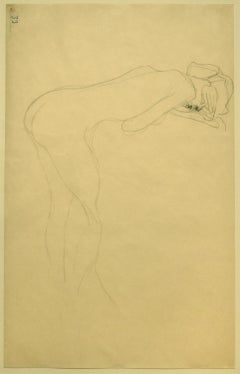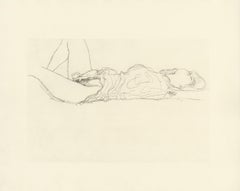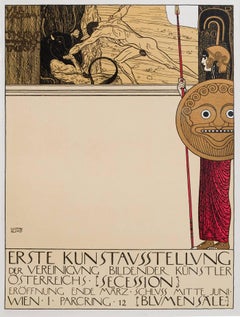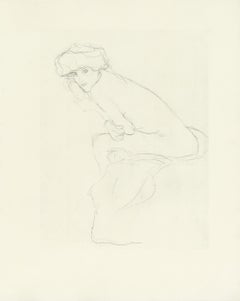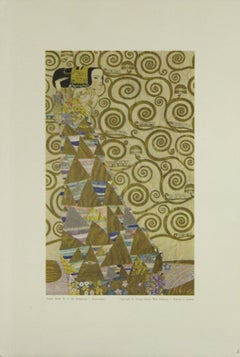Gustav Klimt Art
Austrian, 1862-1918
Gustav Klimt was an Austrian symbolist painter and a prominent member of the Vienna Secession movement. Klimt's primary subject was the female body and his works are mostly erotic in nature.to
4
19
13
2
Overall Width
to
Overall Height
to
4
30
25
2
29
23
11
25
15
11
11
6
6
5
4
4
4
2
2
2
2
2
2
1
1
1
1
25
8
1
36
8,227
2,805
1,656
1,313
5
3
33
1
Artist: Gustav Klimt
Nude of Woman Reclined on the Back of a Chair on the Right, Original Drawing
By Gustav Klimt
Located in Roma, IT
Nude of Woman Reclined On the Back of a Chair on the Right is an original drawing realized by Gustav Klimt between 1904 and 1906, probably in 1905, as stated in the Catalogue Raisonn...
Category
Early 1900s Vienna Secession Gustav Klimt Art
Materials
Charcoal
Gerlach's Allegorien Folio, plate #58: "Sculpture" Lithograph, Gustav Klimt.
By Gustav Klimt
Located in Chicago, IL
As an artist trained in the applied arts, Gustav Klimt valued all forms of art, including the graphic arts. This final design from 1896 for inclusion in Allegorien published by Gerlach & Schenk demonstrates respect for artistic precedent and for a wide range of media and technique. The publication was printed in an unknown number of copies. Klimt’s rendering in latin of the title, “SCVLPTVR.,” with three-dimensional effect on the wall, is a figurative allusion to this medium as well as a literal reference to Ancient Rome. By doing the same with his signature and date in roman numerals on the right hand side of the image, Klimt places himself, The Artist, firmly in this linear and legitimizing context of art history and as its modern standard-bearer. Playing on Classical mythology and the story of Pygmalion, in which a statue comes to life, Klimt presents his modern Venus holding an apple. Klimt’s Venus exhibits a curvilinear softness; there are no angles. Klimt deftly shows the possibilities in a graphic image to give life to dark, wavy hair and tenderness to swelling breasts and belly. To further emphasize the allegory of thriving modern art, he contrasts his Venus with the cold, hard ancient classical head whose eyes are vacuous and whose hair is but a stylized mass of curls. Klimt’s living Venus stands in front of the large bust and large classical pillar upon which is a sculpture of a Sphinx and a Greek Attic bust. As if a gallery to represent sculpture’s “best of” through the ages, the upper horizontal panel includes bust depictions in marble, cast metal and wood...
Category
1890s Vienna Secession Gustav Klimt Art
Materials
Lithograph
"Masturbating Woman" by Gustav Klimt - Original Print from Courtesans Folio
By Gustav Klimt
Located in Chicago, IL
Plate #9 from Gustav Klimt's 1907 "Dialogues of the Courtesans" portfolio, consisting of 15 collotypes on cream japon paper. The drawings in this folio are said to be studies for Klimt's well-known Water Serpents paintings...
Category
Early 1900s Vienna Secession Gustav Klimt Art
Materials
Paper
Ottokar Mascha Folio, plate 8: "Poster for the 1st Vienna Secession Exhibition"
By Gustav Klimt
Located in Chicago, IL
After GUSTAV KLIMT (1862-1918) THESEUS UND MINOTAURUS, 1898, final design submission for poster advertising the first exhibition of the Vienna Secession, (In Mascha, no. 8) As a cele...
Category
1910s Vienna Secession Gustav Klimt Art
Materials
Lithograph
"Woman Leaning Forward" by Gustav Klimt - Original Print from Courtesans Folio
By Gustav Klimt
Located in Chicago, IL
Plate #3 from Gustav Klimt's 1907 "Dialogues of the Courtesans" portfolio, consisting of 15 collotypes on cream japon paper. The drawings in this folio are said to be studies for Klimt's well-known Water Serpents paintings...
Category
Early 1900s Vienna Secession Gustav Klimt Art
Materials
Paper
Expectation-Metallic Poster. Printed in Austria
By Gustav Klimt
Located in Chesterfield, MI
Poster. Measures 16 x 11 inches and is Unframed. Good/Fair Condition-signs of wear consistent with age and handling.
Category
Late 20th Century Gustav Klimt Art
Materials
Lithograph
$140 Sale Price
20% Off
"Women Sleeping Face Down" by Gustav Klimt - Original Print from Courtesan Folio
By Gustav Klimt
Located in Chicago, IL
Plate #12 from Gustav Klimt's 1907 "Dialogues of the Courtesans" portfolio, consisting of 15 collotypes on cream japon paper. The drawings in this folio are said to be studies for Klimt's well-known Water Serpents paintings...
Category
Early 1900s Vienna Secession Gustav Klimt Art
Materials
Paper
"Reclined Woman w/Necklace" by Gustav Klimt - Original Print - Courtesans Folio
By Gustav Klimt
Located in Chicago, IL
Plate #7 from Gustav Klimt's 1907 "Dialogues of the Courtesans" portfolio, consisting of 15 collotypes on cream japon paper. The drawings in this folio are said to be studies for Klimt's well-known Water Serpents paintings...
Category
Early 1900s Vienna Secession Gustav Klimt Art
Materials
Paper
"Couple Making Love" by Gustav Klimt - Original Print from Courtesans Folio
By Gustav Klimt
Located in Chicago, IL
Plate #4 from Gustav Klimt's 1907 "Dialogues of the Courtesans" portfolio, consisting of 15 collotypes on cream japon paper. The drawings in this folio are said to be studies for Kli...
Category
Early 1900s Vienna Secession Gustav Klimt Art
Materials
Paper
"Three Women Asleep" by Gustav Klimt - Original Print from Courtesans Folio
By Gustav Klimt
Located in Chicago, IL
Plate #13 from Gustav Klimt's 1907 "Dialogues of the Courtesans" portfolio, consisting of 15 collotypes on cream japon paper. The drawings in this folio are said to be studies for Klimt's well-known Water Serpents paintings...
Category
Early 1900s Vienna Secession Gustav Klimt Art
Materials
Paper
Gerlach's Allegorien Folio, plate #53: "Junius" Lithograph, Gustav Klimt.
By Gustav Klimt
Located in Chicago, IL
Contributors to Gerlach & Schenk’s publications valued design and innovation in the graphic arts just as much as they examined allegories as subject matter for exploration. Here, Gus...
Category
1890s Vienna Secession Gustav Klimt Art
Materials
Lithograph
"Sleeping Woman" by Gustav Klimt - Original Print from Courtesans Folio
By Gustav Klimt
Located in Chicago, IL
Plate #1 from Gustav Klimt's 1907 "Dialogues of the Courtesans" portfolio, consisting of 15 collotypes on cream japon paper. The drawings in this folio are said to be studies for Kli...
Category
Early 1900s Vienna Secession Gustav Klimt Art
Materials
Paper
"Sleeping Couple" by Gustav Klimt - Original Print from Courtesans Folio
By Gustav Klimt
Located in Chicago, IL
Plate #15 from Gustav Klimt's 1907 "Dialogues of the Courtesans" portfolio, consisting of 15 collotypes on cream japon paper. The drawings in this folio are said to be studies for Kl...
Category
Early 1900s Vienna Secession Gustav Klimt Art
Materials
Paper
Death and Life by Gustav Klimt, Das Werk lifetime collotype, 1908-1912
By Gustav Klimt
Located in Chicago, IL
Original collotype created from Gustav Klimt’s Death and Life, painted in 1908. Published and edited by Verlag H.O. Miethke and printed by k.k. Hof- und St...
Category
Early 1900s Vienna Secession Gustav Klimt Art
Materials
Paper
"Seated Woman Semi-nude" by Gustav Klimt - Original Print from Courtesans Folio
By Gustav Klimt
Located in Chicago, IL
Plate #2 from Gustav Klimt's 1907 "Dialogues of the Courtesans" portfolio, consisting of 15 collotypes on cream japon paper. The drawings in this folio are said to be studies for Klimt's well-known Water Serpents paintings...
Category
Early 1900s Vienna Secession Gustav Klimt Art
Materials
Paper
"Die Hexe" Art Nouveau Lithograph by Gustav Klimt for Ver Sacrum
By Gustav Klimt
Located in Chicago, IL
Ver Sacrum (meaning "Sacred Spring" in Latin) was conceived by Gustav Klimt, Max Kurzweil and Ludwig Hevesi. During its six years of activity, 471 original drawings were made specifi...
Category
1890s Art Nouveau Gustav Klimt Art
Materials
Lithograph
"Smiling Woman Reclined" by Gustav Klimt - Original Print from Courtesans Folio
By Gustav Klimt
Located in Chicago, IL
Plate #14 from Gustav Klimt's 1907 "Dialogues of the Courtesans" portfolio, consisting of 15 collotypes on cream japon paper. The drawings in this folio are said to be studies for Klimt's well-known Water Serpents paintings...
Category
Early 1900s Vienna Secession Gustav Klimt Art
Materials
Paper
Fulfilment-Metallic Poster. Printed in Austria
By Gustav Klimt
Located in Chesterfield, MI
Poster. Measures 28.75 x 18.5 inches and is Unframed. Good/Fair Condition-signs of wear consistent with age and handling (please see secondary images for details).
Category
Late 20th Century Gustav Klimt Art
Materials
Lithograph
$172 Sale Price
20% Off
"Woman Leaning Over Chair" by Gustav Klimt - Original Print from Courtesan Folio
By Gustav Klimt
Located in Chicago, IL
Plate #8 from Gustav Klimt's 1907 "Dialogues of the Courtesans" portfolio, consisting of 15 collotypes on cream japon paper. The drawings in this folio are said to be studies for Kli...
Category
Early 1900s Vienna Secession Gustav Klimt Art
Materials
Paper
"Masturbating Woman on Couch" by Gustav Klimt - Original Print - Courtesan Folio
By Gustav Klimt
Located in Chicago, IL
Plate #5 from Gustav Klimt's 1907 "Dialogues of the Courtesans" portfolio, consisting of 15 collotypes on cream japon paper. The drawings in this folio are said to be studies for Kli...
Category
Early 1900s Vienna Secession Gustav Klimt Art
Materials
Paper
"Woman w/Lace Garment" by Gustav Klimt - Original Print from Courtesans Folio
By Gustav Klimt
Located in Chicago, IL
Plate #6 from Gustav Klimt's 1907 "Dialogues of the Courtesans" portfolio, consisting of 15 collotypes on cream japon paper. The drawings in this folio are said to be studies for Klimt's well-known Water Serpents paintings...
Category
Early 1900s Vienna Secession Gustav Klimt Art
Materials
Paper
Gerlach's Allegorien, plate #46: "Love" Lithograph, Gustav Klimt.
By Gustav Klimt
Located in Chicago, IL
Klimt’s association with Martin Gerlach dates back to the early 1880s when Gerlach and Schenk published their first edition of Allegorien und Embleme. By the mid-1890s, they were pla...
Category
1890s Vienna Secession Gustav Klimt Art
Materials
Lithograph
Beethoven Frieze (detail) by Gustav Klimt, Das Werk collotype, 1908-1912
By Gustav Klimt
Located in Chicago, IL
Original collotype created from a detail of Gustav Klimt’s Beethoven Frieze. Published and edited by Verlag H.O. Miethke and printed by k.k. Hof- und Staatsdruckerei, Vienna, in an e...
Category
Early 1900s Vienna Secession Gustav Klimt Art
Materials
Paper
Fruit Trees by Gustav Klimt, Das Werk lifetime landscape collotype, 1908-1912
By Gustav Klimt
Located in Chicago, IL
Original collotype created from Gustav Klimt’s Impressionist Fruit Trees landscape, painted in 1901. Published and edited by Verlag H.O. Miethke and printed by k.k. Hof- und Staatsdruckerei, Vienna, in an edition of 300.
Between 1908 and 1914, H.O. Miethke published Das Werk Gustav Klimts...
Category
Early 1900s Vienna Secession Gustav Klimt Art
Materials
Paper
Schloss Kammer Lake Attersee II by Gustav Klimt, Das Werk collotype, 1908-1912
By Gustav Klimt
Located in Chicago, IL
Original collotype created from Gustav Klimt’s Schloss Kammer on Lake Attersee II (Das Werk Gustav Klimts), originally painted in 1909. Publishe...
Category
Early 1900s Vienna Secession Gustav Klimt Art
Materials
Paper
Church in Cassone by Gustav Klimt, Das Werk lifetime collotype, 1908-1912
By Gustav Klimt
Located in Chicago, IL
Original collotype created from Gustav Klimt’s Church in Cassone, painted in 1913. Published and edited by Verlag H.O. Miethke and printed by k.k. Hof- und Staatsdruckerei, Vienna, in an edition of 300.
Between 1908 and 1914, H.O. Miethke published Das Werk Gustav Klimts...
Category
Early 1900s Vienna Secession Gustav Klimt Art
Materials
Paper
Farm Garden Sunflowers by Gustav Klimt, Das Werk lifetime collotype, 1908-1912
By Gustav Klimt
Located in Chicago, IL
Original collotype created from Gustav Klimt’s Farm Garden With Sunflowers, painted in 1913. Published and edited by Verlag H.O. Miethke and printed by k.k. Hof- und Staatsdruckerei, Vienna, in an edition of 300.
Between 1908 and 1914, H.O. Miethke published Das Werk Gustav Klimts...
Category
Early 1900s Vienna Secession Gustav Klimt Art
Materials
Paper
The Swamp by Gustav Klimt, Das Werk lifetime landscape collotype, 1908-1912
By Gustav Klimt
Located in Chicago, IL
Original collotype created from Gustav Klimt’s The Swamp, painted in 1900. Published and edited by Verlag H.O. Miethke and printed by k.k. Hof- und Sta...
Category
Early 1900s Vienna Secession Gustav Klimt Art
Materials
Paper
Malcesine on Lake Garda by Gustav Klimt, Das Werk landscape collotype, 1908-1912
By Gustav Klimt
Located in Chicago, IL
Original collotype created from Gustav Klimt’s Malcesine on Lake Garda, painted in 1913. Published and edited by Verlag H.O. Miethke and printed by k.k. Hof- und Staatsdruckerei, Vienna, in an edition of 300.
Between 1908 and 1914, H.O. Miethke published Das Werk Gustav Klimts...
Category
Early 1900s Vienna Secession Gustav Klimt Art
Materials
Paper
Gustav Klimt Sketch of a Woman Catalogued
By Gustav Klimt
Located in Dallas, TX
Gustav Klimt (Austrian, 1862-1918)
Frauenkopf nach rechts, 1916
Pencil on paper
Dimensions: 22.5 x 14.75 Inches (57.2 x 37.5 cm) (sheet)
Stamped lower right: GUSTAV / KLIMT / NACHLAS...
Category
1910s Aesthetic Movement Gustav Klimt Art
Materials
Paper
$41,600 Sale Price
20% Off
Farmhouse in Buchberg by Gustav Klimt, Das Werk lifetime collotype, 1908-1912
By Gustav Klimt
Located in Chicago, IL
Original collotype created from Gustav Klimt’s Farmhouse in Buchberg (Upper Austrian Farmhouse), painted in 1911. Published and edited by Verlag H.O. Miethke and printed by k.k. Hof- und Staatsdruckerei, Vienna, in an edition of 300.
Between 1908 and 1914, H.O. Miethke published Das Werk Gustav Klimts...
Category
Early 1900s Vienna Secession Gustav Klimt Art
Materials
Paper
Fulfilment-Metallic Poster. Printed in Austria
By Gustav Klimt
Located in Chesterfield, MI
Poster. Measures 16 x 11 inches and is Unframed. Good/Fair Condition-signs of wear consistent with age and handling (please see secondary images for details).
Category
Late 20th Century Gustav Klimt Art
Materials
Lithograph
$140 Sale Price
20% Off
Thunderstorm (The Large Poplar II) by Gustav Klimt, Das Werk lifetime collotype
By Gustav Klimt
Located in Chicago, IL
Original collotype created from Gustav Klimt’s Approaching Thunderstorm (The Large Poplar II), painted in 1903. Published and edited by Verlag H.O. Miethke and printed by k.k. Hof- und Staatsdruckerei, Vienna, in an edition of 300.
Between 1908 and 1914, H.O. Miethke published Das Werk Gustav Klimts, a folio of collotypes representing Gustav Klimt’s most notable works leading up to 1913. Klimt’s original oil paintings were painstakingly reproduced as collotypes on a handmade, deckled-edge cream wove paper using a complex gravure process overseen by master technicians as well as the artist himself. Each image presented in the folio was assigned its own unique signet, which was designed by Klimt and struck below the image using a technique similar to letterpress. The signet corresponded to a matching signet in the justification page which detailed the piece’s size, location, and owner.
Published under the artist’s direct supervision, this series allowed Klimt, who had completely divorced himself from public commissions following the outcry from his University of Vienna paintings, to more effectively present his artworks to institutions and patrons across the world. A testament to the masterful design and printmaking demonstrated by Das Werk Gustav Klimts, Emperor Franz Joseph himself purchased the first copy of the folio.
Klimt’s The Swamp...
Category
Early 1900s Vienna Secession Gustav Klimt Art
Materials
Paper
Portrait of Lady in Red and Black by Gustav Klimt, Das Werk collotype, 1908-1912
By Gustav Klimt
Located in Chicago, IL
Original collotype created from Gustav Klimt’s Portrait of Lady in Red and Black. Published and edited by Verlag H.O. Miethke and printed by k.k. Hof- und Staatsdruckerei, Vienna, in an edition of 300. Collotype on chine colle paper laid down on heavy deckled-edge cream-wove paper.
Between 1908 and 1914, H.O. Miethke published Das Werk Gustav Klimts...
Category
Early 1900s Vienna Secession Gustav Klimt Art
Materials
Paper
Gustav Klimt art for sale on 1stDibs.
Find a wide variety of authentic Gustav Klimt art available for sale on 1stDibs. If you’re browsing the collection of art to introduce a pop of color in a neutral corner of your living room or bedroom, you can find work that includes elements of orange and other colors. You can also browse by medium to find art by Gustav Klimt in paper, lithograph, charcoal and more. Much of the original work by this artist or collective was created during the 20th century and is mostly associated with the Expressionist style. Not every interior allows for large Gustav Klimt art, so small editions measuring 11 inches across are available. Customers who are interested in this artist might also find the work of Koloman Moser, Oskar Kokoschka, and Carl Otto Czeschka. Gustav Klimt art prices can differ depending upon medium, time period and other attributes. On 1stDibs, the price for these items starts at $175 and tops out at $86,896, while the average work can sell for $3,850.
Artists Similar to Gustav Klimt
Questions About Gustav Klimt Art
- 1stDibs ExpertAugust 8, 2024How much a Klimt painting is worth depends on its condition, history, rarity and other factors. In 2023, The Lady with a Fan sold for $108.4 million, setting a new record for the artist. An Austrian painter, Klimt played a key role in the Vienna Secession movement. He is best known for his paintings depicting the female body, drawing inspiration from traditional Japanese art and Byzantine mosaics. A certified appraiser or knowledgeable dealer can provide an estimated value for Gustav Klimt paintings. Find a collection of Gustav Klimt art on 1stDibs.
- 1stDibs ExpertAugust 8, 2024Gustav Klimt was inspired by a few things. The Austrian painter drew inspiration from traditional Japanese artwork and from pieces produced by other western artists, such as Fernand Khnopff and Vincent van Gogh. In addition, he found decorative Byzantine mosaics to be inspiring. In fact, you can see their influence in many of his works, including The Kiss and The Tree of Life, Stoclet Frieze. Find an assortment of Gustav Klimt art on 1stDibs.
- What art did Gustav Klimt do?1 Answer1stDibs ExpertApril 5, 2022Gustav Klimt was an Austrian painter and sculptor whose primary focus was on female subjects. An symbolist painter and a prominent member of the Vienna Art Nouveau movement, Klimt was well-known for his erotic and highly ornate style, although he also painted landscapes and figurative works. Find a collection of authentic Gustav Klimt artwork from trusted art dealers on 1stDibs.
- 1stDibs ExpertAugust 26, 2024Yes, Gustav Klimt used real gold in some of his paintings. Specifically, Klimt applied gold leaf to his works. One of the early examples of this technique is found in Judith and the Head of Holofernes, which he painted in 1901. Find an assortment of Gustav Klimt art on 1stDibs.
- 1stDibs ExpertMarch 13, 2024Gustav Klimt's most famous piece is arguably The Kiss. Painted in 1908, the work shows an embracing man and woman draped in gold finery. The piece is oil on canvas and is now in the Österreichische Galerie Belvedere museum in Vienna, Austria. Explore a collection of Gustav Klimt art on 1stDibs.
